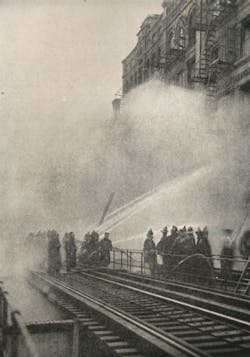AMITYVILLE, NY: MAY 3, 1914 – Flames broke out in the hayloft of a large barn on the estate of Benjamin F. Yoakum, a railroad tycoon. The quick-moving fire spread to five other barns and was threatening the mansion before local firemen, aided by mutual aid from Farmingdale, brought the blaze under control.
JERSEY CITY, NJ: MAY 3, 1914 – While responding to a fire on Morris Avenue, three fire apparatus reached the triple intersection of Newark Avenue and Warren and Montgomery streets at the same time. Engine 3, Engine 1 and a chief’s car were closing on each other at a high rate of speed. With a split-second decision, the chief’s driver had to choose between hitting a building or Engine 3. He chose the pumper. The car struck the engine and both the driver and his chief were ejected. Assistant Chief Hudson Lovell was thrown 50 feet from his car and landed unconscious on the pavement. His driver, also injured, raced to the chief’s side and flagged a passing automobile. The unconscious chief was placed in the car and taken to the hospital. The 25-year veteran died as a result of a fractured skull.
VALPARAISO, CHILE: MAY 3, 1914 – More than 50 people were killed by a blaze that tore through the commercial section of the city. Firemen faced a raging fire within the flimsy construction of the buildings on Echaurren Square. The fire swept across more than 2½ acres, leaving more than 150 persons injured.
WYMORE, NE: MAY 9, 1914 – A rubbish fire behind a furniture store ignited the store and began to spread to other buildings. It was just after noon when the wind-driven fire extended from building to building in the business section of town. Wymore firemen called to nearby Beatrice for additional firemen and apparatus. The united departments were joined by every able-bodied man in town trying to halt the spreading wall of fire. The battle raged for 3½ hours until the fire was brought under control. Six major businesses were destroyed.
NEWARK, NJ: MAY 9, 1914 – A fire was discovered in the six-story Aldine Apartments on Garside Street at 3:15 in the morning. Flames were roaring up the stairway and elevator shaft, trapping all the tenants inside. Four alarms were transmitted as the fire burned through the roof and firemen scrambled to rescue those trapped within the inferno. With the stairs gone, firemen directed their efforts from outside, raising ladders, stretching hoses up fire escapes and applying water tower streams. Firemen using a combination of aerial ladders, portable ladders, fire escapes and life nets rescued 50 people. Despite the heroic efforts of the fire department, the flames killed four people.
DEMING, NM: MAY 12, 1914 – A fire was reported in a building housing a hat shop and the Western Union Telegraph Office at 11 P.M. Firemen were quickly on scene, but were soon faced with major water problems. As the firemen struggled to find adequate water pressure, the flames intensified. The fire spread to a bank, a grocery store, a hotel and several other buildings as firemen prepared to make a stand. They stopped the fire from crossing an alley and igniting the next block of buildings.
NEW YORK CITY: MAY 18, 1914 – An extremely dangerous and difficult fire was battled in the Atlantic Can Co. building on Desbrosses Street in Manhattan. The fire started among iron carboys (five-gallon containers) containing muriatic and hydrochloric acids used in the soldering of tin cans. Fumes from the exploding containers took a heavy toll on the mask-less firemen. The fumes and the thick smoke poured from the top five floors of the six-story building, causing the evacuation of the neighborhood and the halting of the Ninth Avenue elevated subway. Chief John Kenlon was overcome three separate times during the blaze. Conditions became so severe that hoses were lashed to the elevated train structure, then abandoned as fireman after fireman collapsed while manning them. The men were ordered to have ropes attached to them so they could be pulled away when they went down.
PRESTON, MN: MAY 23, 1914 – The advent of Prohibition posed many unusual situations in counties and towns across the nation. One unique situation occurred when a fire broke out in the Preston Brewery while a “dry” picnic was being held nearby to celebrate Prohibition. (At the time, it was illegal to sell liquor in this county, but not to make it.) When the fire started, men from the picnic, foes of alcohol, joined firemen and fought valiantly to save the brewery. The combined force succeeded and the business was saved with minor damage.
DETROIT, MI: MAY 25, 1914 – While a train was speeding toward Detroit, the conductor noticed a farmhouse ablaze. He stopped the train, raced to the burning building and rescued an elderly man. A bucket brigade was then formed using water from the locomotive passed toward the fire by the train passengers until the fire was extinguished.
About the Author
Paul Hashagen
PAUL HASHAGEN, a Firehouse® contributing editor, is a retired FDNY firefighter who was assigned to Rescue 1 in Manhattan. He is also an ex-chief of the Freeport, NY, Fire Department. Hashagen is the author of FDNY: The Bravest, An Illustrated History 1865-2002, the official history of the New York City Fire Department, and other fire service books.
Connect with Paul
Website: paulhashagen.com
Facebook: Paul Hashagen-author
